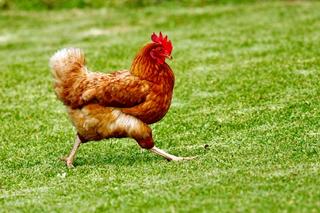Coccidiosis In Chickens ... Transmission, diagnosis, and treatment


By Maurice Pitesky
July 27, 2023
Avian intestinal coccidiosis is a common protozoal gastrointestinal (GI) disease that primarily affects young chickens. Clinical signs include mucus-like or bloody diarrhea, dehydration, anemia, listlessness, ruffled feathers, stunted growth, and death. Coccidiosis is also commonly associated with a drop in egg production.
Chickens can carry nine different types of coccidia, but the presence of a few coccidial eggs (or oocysts) may not equal a diagnosis of the disease.
The differences and subtleties of the nine types can be difficult for poultry owners who simply want to know if their chickens have coccidia. Add to this the difficulty controlling coccidiosis in mixed-aged flocks—where older, “healthy” chickens can infect the younger chicks—and things become complicated.
Coccidiosis 101
Coccidiosis refers to disease from protozoa, or single-celled organisms, from the genus Eimeria. Chickens have nine different species of coccidia. Each species of Eimeria is unique, and exposure to one species does not afford protection to others.
That means no anticoccidial medication is effective against every species of coccidia, so identification is key for treatment and control.
A single oocyst can infect and destroy thousands of intestinal cells. As coccidia are shed in the feces, the resulting spores can remain viable for months. Once ingested by another chicken, the life cycle begins again.
It is important to recognize that coccidia are common in the poultry environment—their presence is not necessarily a sign of poor care.
However, if chickens are exposed to moderate numbers of oocysts, they will typically develop immunity towards that species.
Transmission
Infection is via the fecal-oral route. Under the right environmental conditions, the oocysts can contaminate all areas of the chicken’s environment, including feed, litter, and soil, and be viable for months. Consequently, controlling substrate and litter moisture levels becomes essential.
The substrate or litter material should be “friable,” meaning it should clump in your hand but also crumble easily. Too dry, and it can be inhaled by the chickens (and their owners). If it’s too wet, it will clump and not come apart. Wet litter may have a strong ammonia smell which can cause coccidial overgrowth and other flock management problems.
Like us, birds are more susceptible to disease if they are immunosuppressed from another illness or stress. Likewise, intestinal coccidiosis may predispose birds to other concurrent intestinal infections such as necrotic enteritis, salmonellosis, and viral intestinal infections. This makes it even more essential to create a healthy environment for your chickens.
Humans can transmit coccidiosis, too, through shoes and equipment. To sidestep this, limit access to your flock and be smart about visiting others.
In the commercial poultry industry, it’s standard practice to wear booties and hair nets, wash your car before and after your visit, and wait at least 24 hours before visiting a new flock of birds.
Diagnosis
Because coccidia are intermittently shed in the feces of chickens, a negative test does not mean the animal is not infected. Due to the potential for false negatives coupled with the possibility of coccidial transmission to the remainder of the flock, birds with clinical signs are typically euthanized to complete a thorough post-mortem examination.
In a postmortem examination, a veterinarian will open up the GI tract and look for lessons that are consistent with coccidia. Finally, the veterinarian will collect a sample of the intestine and look at the material under the microscope. A definitive diagnosis can be made from this examination.
It is important to remember that because coccidia is so prevalent, it is often found in the feces or intestines of chickens only at necropsy. The significance of that finding is weighed against the visual and microscopic damage to the intestines.
Treatment
If one or two of your chickens were definitively diagnosed with coccidia, treat the remainder of your flock sharing that environment with Amprolium (0.024 percent of the active ingredient in drinking water for three to five days).
Sulfa drugs (like sulfamethazines administered at 0.1 percent for two days) are also effective, but shouldn’t be used in laying hens.
NOTE: Contact the Food Animal Residue Avoidance Databank (www.farad.org) for any drug to find up-to-date information on withdrawal times for eggs and meat.
No anti-coccidial is effective against all the different strains of coccidia and that over time, coccidia can become drug resistant. As a result, the above-mentioned drugs should only be used to treat an affected flock and not as a preventative program. Contact your veterinarian about using a rotation of different anti-coccidials if they are used regularly.
Prevention
Disease prevention is always more desirable than treatment. There are several relatively simple prevention methods that should be utilized by all poultry owners:
Controlling moisture with the appropriate installation and management of watering systems. Specifically, using nipple drinkers to reduce spillage of water onto litter instead of bell and trough drinkers.
If at all possible, periodically move the location of your chickens. Any area that is consistently covered with manure will eventually have a high load of bacteria, viruses, and parasites—like coccidia. Leaving land fallow for several weeks is one of the most effective ways to reduce the pathogen load in the environment.
Including anticoccidials—such as medicated feed—into diets at recommended levels will prevent clinical infection. This is very important for the first month of the chick’s life since her immune system hasn’t fully developed.
Good biosecurity: Coccidial oocysts are normally brought in through contaminated equipment.
Full immunity is not reached in chickens until approximately seven weeks of age. To keep from spreading infection yourself, it is essential to always wash your hands after working with chickens.
Tags:Chicken Chatter

Acreage Life is part of the Catalyst Communications Network publication family.














